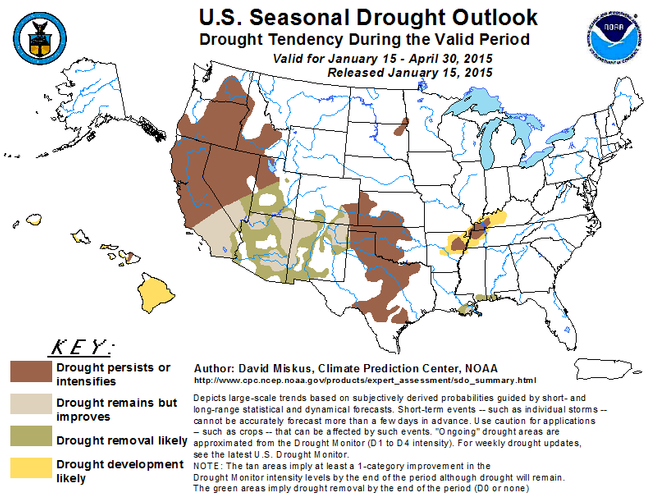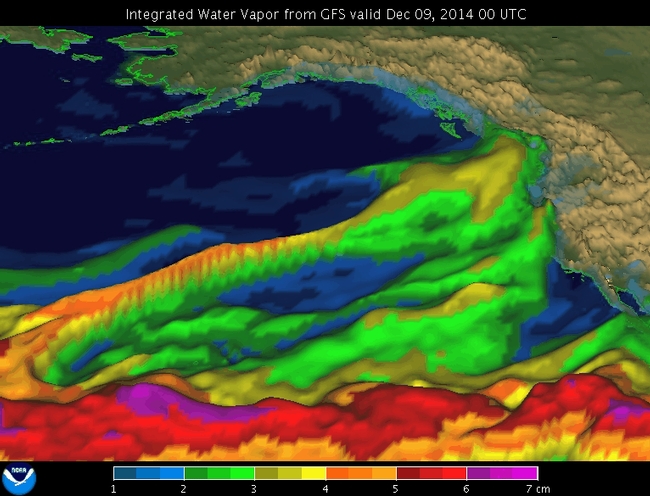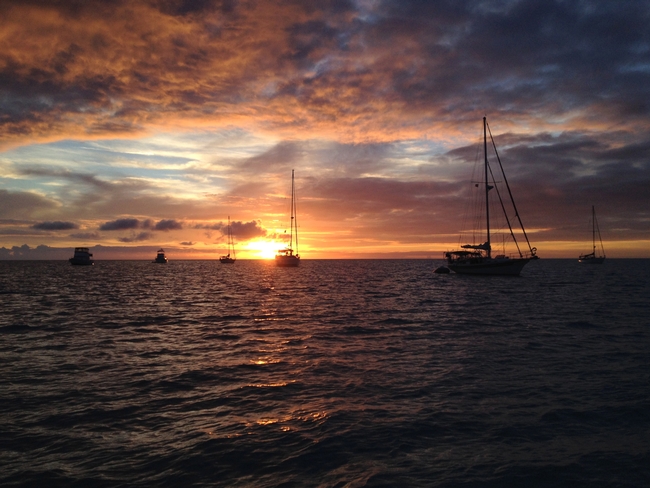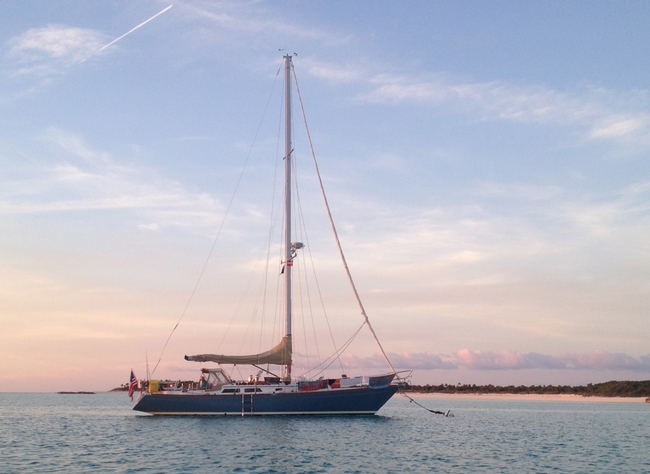Musings about climate change, water, and society
What matters to Katie Markovich
UC Davis recently profiled CCWAS Trainee Katie Markovich. Check it out!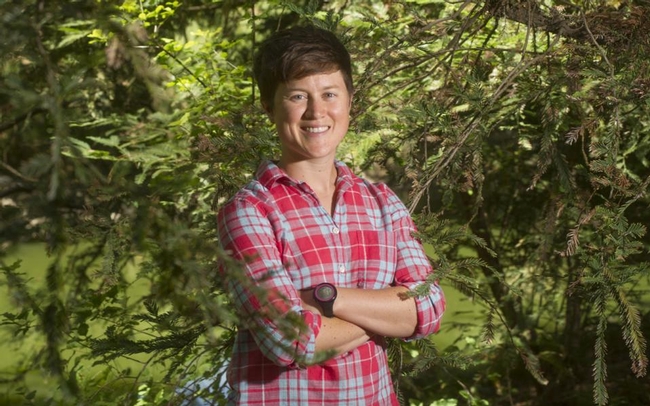
January was dry. So where does that leave us?
It seems clear from the last blog post that the optimism inspired by late December rains has now been overshadowed by one of the warmest and driest Januaries on record. This left me wondering what this means for California's ongoing multi year drought? We usually talk about drought in the summer, so how important is January precipitation?
Short answer: really important.
This time of year, water managers are usually paying close attention to the snowpack. Although water demand peaks in the summer months, a significant portion of the water supply actually falls as snow during the winter where it is stored in the snowpack until it melts and runs off into reservoirs in the spring. Snow accumulated in the winter (generally from October to March) provides roughly 1/3 of the total water supply for California. On average, this equates to more than 15 million acre feet of water, which is more than all of the water used by CA cities in 2010.
January is typically the wettest month and is an important contributor to the total snowpack. Unfortunately, this year two factors are resulting in below average numbers. First, it's not snowing; this January was the driest on record in many locations. Second, above average temperatures actually melted some of the snow that was accumulated in December. The resulting snowpack totals for January are not encouraging. As of February 2nd, the overall water storage in the snowpack is 22% of normal for this time of year, and only 14% of the average April 1st total (the standard date used for peak snowpack measurements). The picture is even bleaker considering that, given the three consecutive years of drought preceding this one, what we really should be shooting for is wet, not average.
Based on the current snowpack, the probability of ending the drought this water year seems low. To make up for the current drought deficit, it's estimated that California will need precipitation totals that are 150% of normal by September 30th. To achieve this, the snowfall in February and March will need to be well above average, and current forecasts are not predicting this. The most recent seasonal drought outlook issued by the National Oceanic and Atmospheric Administration (NOAA), shown here, actually predicts that drought will persist or intensify in Northern California.
Given this trajectory, it is likely that another year of drought is probable, if not certain. However, this is not to say that this year can't be better than last. I would like to close with two positive observations. First, the reservoir levels this month are actually slightly better than this time last year. Also, its only the beginning of February, which means that there are still two months left in the snow season for these numbers to improve.
Wet December, Dry January: Thoughts about California Rain
With the heavy rains that hit northern California in December, the buzzing about snow in San Diego County, and the more recent rainfall in Los Angeles, I was curious as to how much that precipitation helped dampen California soil as the state enters its fourth year of drought. In summary, although it provided temporary drought relief, the recent precipitation was nothing compared to the 11 trillion gallons of water NASA predicted in December 2014 that is needed to get California out of this long-term drought. On the bright side, it looks as if our conference will be timely and I can continue to avoid the discomfort of closed-toed shoes.
Although the rains didn't even put a dent into the amount needed, they were quite intense! In fact, San Jose set an all-time record for wettest December day in its history and extreme winds hit several parts of the west coast. The prolonged December precipitation was due to the combination of an atmospheric river and a surface low pressure area off the coast of northern California. It'll be interesting to see the changes in the development and movement of atmospheric rivers over the century as climate change continues to occur. Some say they will grow stronger because a warmer climate means more water vapor can be lifted out of the ocean. (NOAA has just launched a cool new campaign, CalWater 2015, dedicated to better understanding atmospheric rivers. Check it out here!).
|
Animation of an atmospheric river from December 2014. See http://www.esrl.noaa.gov/psd/atmrivers/ |
Unlike December, January turned out to be incredibly dry and cold. Although it's not unusual for several dry weeks in January, we've gone all month without a drop! Things aren't looking good for the Sierra snowpack (more info on this next week from Laura!). Daniel Swain has an explanation for this mixed bag of California weather events:
A high-amplitude atmospheric flow pattern has once again developed over the Eastern Pacific and North America, deflecting the Pacific storm track north of its typical cool-season position along the West Coast and allowing repeated intrusions of extremely cold Arctic air to invade the American Midwest and Eastern Seaboard.
Sound familiar? As of January 17th, however, there still hasn't been strong enough evidence to say that the Ridiculously Resilient Ridge has returned…stay tuned.
Assessing drought and looking forward: A day of discussion hosted by PPIC
On Monday, January 12, the Public Policy Institute of California (PPIC) hosted an event in downtown Sacramento entitled Managing Drought, which brought together prominent leaders in the scientific, private sector, management, policy, and government arenas to discuss current and future droughts in California. It created an opportunity to reflect on what's happening, what's not happening, and what should happen when it comes to drought management in California today and in the future.
In the first keynote address, California State Climatologist Mike Anderson brought everyone in the room (and the webcast) up to speed on the California drought and climate change implications. Citing recent publications, Anderson emphasized that not only is California's precipitation highly variable from year to year but whether we're wet or dry depends upon just a few storm events.(1,2) With regard to the current drought, Anderson stressed that much is missed in just the basic statistics, reminding the audience that more demands and much warmer temperatures (as a result of climate change) exacerbate drought impacts.
Jane Doolan, a professor at the University of Canberra and a member of the National Water Commission in Australia, delivered the second keynote on Australia's millennium drought. She provided insights from a policy perspective on what did and did not work. The policy response to the drought, Doolan explained, was approached with the perspective that the changes were for long term viability, not simply a response to crisis – an issue that was echoed throughout the day. Australia employed several principles: policies should
- work under drier futures,
- improve efficiency and conservation,
- allow water right holders to mitigate risk,
- support water markets, and
- offer multi-benefit solutions.
Some key changes included adding to the water grid which made it easier to move water around and the establishment of an environmental water management portfolio with “clear and unambiguous water for the environment.” Doolan cautioned that with recent floods, people are now saying that many of the changes aren't needed, illustrating the importance of building policies for the long term.
To address legislative priorities, the first panel was moderated by water law expert Buzz Thompson of Stanford University and consisted of four legislators: Jean Fuller, Marc Levine, Anthony Rendon, and Lois Wolk. With regard to funding related to the 2014 Proposition 1 (water bond) and California Sustainable Groundwater Act, remarks centered on the importance of using the money strategically, treating it as a “down payment,” and using it to build infrastructure. Top oversight priorities for the legislators were water storage, tools for local entities, emerging technologies, and guidance on goals for local resilience under climate change. Given the focus on local communities, concern was raised over local entities being unable to raise rates (Proposition 218 requires a two thirds vote). The importance of getting allocated money out the door to local entities for groundwater studies and plans was emphasized multiple times. When asked the question of what one area the legislators would focus on for drought resilience, Levine discussed learning from countries such as Australia, Rendon stressed government and structure issues, Wolk spoke of the need for better science to determine targets, and Fuller discussed finding the reality of what was possible. Questions from the audience followed. One in particular rung true to which no one had a clear answer: How do we create a new vision on water in California like Australia seems to have done?
The next panel addressed urban and agricultural water scarcity, which was introduced by Jay Lund, a professor and director of the UC Davis Center for Watershed Sciences. His take-homes included a need for more tightly managed water given its scarcity, encouragement of water markets, reformed urban pricing structure, and a need for drills or “dry runs.” Representing a wholesaler water district, Susan Milligan of Calleguas Municipal Water District expressed the need for the state to help address issues they couldn't regulate alone. Joe Macllvaine of Paramount Farms explained that while most agree groundwater management needs to happen, it will cause economic upheaval that needs to be thought about carefully. One of several issues raised by Martha Guzman-Aceves of the Office of the Governor is that there are many sub-questions to be addressed when it comes to implementing water markets. Andrew Fahlund of the California Water Foundation emphasized goal setting and a willingness to test, try, fail, and try again.
This was followed by a panel on managing ecosystems during drought, which was introduced by Jeff Mount of PPIC and Professor Emeritus at UC Davis. Mount's three main points were: 1) investing in ecosystems when times are good, 2) creating a reliable funding source for the environment, and 3) drought planning. Highlights of this panel included an eloquent discussion of the incredible difficulty making choices during times of scarcity and their human toll by Chuck Bonhom, director of the California Department of Fish and Wildlife. Sandi Matsumoto of The Nature Conservancy encouraged us to think about the when, where and how of providing habitat. Peter Moyle, Professor at UC Davis, urged the development of “clear and unambiguous rights for the environment” similar to those established in Australia. Tim Quinn, Executive Director of the Association of California Water Agencies, suggested we need to move to a system that is more flexible and includes multi-purpose strategies.
The last panel on allocating water through the state's water rights system was introduced by Brian Gray of the University of California, Hastings College of Law. He noted that the requirement that we tightly manage water in drought is hampered by a lack of detailed information. We need, he argued, to be more specific about how water is being used so that can be taken into account when curtailments need to happen. A number of key points were made by the panel. Felicia Marcus, Chair of the State Water Resources Control Board, followed on the issue of data needs by pointing out that it's not just availability for researchers and managers but also availability and transparency for everyone. She also stressed that many issues could be solved by better implementing the water rights priority already in place. Other key points included Davis Guy of the Northern California Water Association stressing the issue of protecting storage releases in times of drought, Jill Duerig of Alameda County Zone 7 Water Agency suggesting we improve how we allocate depending on water year, and Bill Croyle of the California Department of Water Resources stated that the emergency created by the drought opened the door to dialog and transparency.
I appreciated this opportunity to hear from a leader on water governance in Australia, California legislators, and other prominent figures in the California water world. Discussions addressed specific topics, but also got to upper level issues including the question of how to sustain momentum to produce lasting change. Though this question is not resolved, it seems to me that discussions such as these are central to promoting its resolution.
More information about the event and videos of the talks and panels can be found on the PPIC website.
Panel on allocating water during drought, with moderator Ellen Hanak from the PPIC. Public Policy Institute of California.
Notes:
1 Dettinger, M.D., Ralph, F.M., Das, T., Neiman, P.J., Cayan, D.R., 2011. Atmospheric Rivers, Floods and the Water Resources of California. Water, 3(2): 445-478.
2 Dettinger, M., Cayan, D.R., 2014. Drought and the California Delta—A Matter of Extremes. San Francisco Estuary and Watershed Science, 12(2).
Water, water, everywhere...
The caption on an old tourist sign in Exuma Cays Land and Sea Park: “Water, water everywhere but not a drop to drink.”
Image: Black Point, Exuma Islands, Bahamas. Photo: Lauren Foster
The full moon is high when my sister and I slip off our 44 foot sailboat to row ashore on Warderick Wells Cay in the Bahamas. Locals in the area assert that if you climb to the highest part of the island at night you can hear cries on the wind, though the varied history of piracy and shipwreck at this spot make the ghosts' identity a mystery.
In the early 18th century it was a hideout for many of the more notorious pirates of the Caribbean and as I look to the south I can see three islands named after Mary Read, Anne Bonney, and Edward Teach (Blackbeard). This spot was an ideal hideout for these famous pirates because it has a protected, hidden harbor deep enough for 12 foot draft pirate ships; a clear view of merchant ships headed through a narrow channel for the Bahama banks from the North Atlantic; but, perhaps most importantly, it is one of the few islands in the area with a supply of fresh water (Exuma Cays Land and Sea Park).
Image: Bronze sculpture of Mary Read and Anne Bonney by Erik Christianson (http://www.erikchristianson.com/sisters-of-the-sea/). Anne and Mary are famous for standing their ground in an attack from Jamaican law enforcers while the rest of their crew fled belowdecks. Mary yelled to her comrades: “if there's a man among ye, ye'll come up and fight like the man ye are to be!” (Abott, 2011).
According to the United Nations, fresh water is designated as a ‘scarce' resource if a country has less than 1,000 m3/capita/year. At 66 m3/capita/year the Bahamas ranked number 177 out of 180 countries for water availability in 2002. The main sources of water in the Bahamas are fresh water lenses in Pleistocene and Holocene limestone aquifers (see Figure 1). Precipitation percolates slowly through the porous limestone, settling on top of the saline seawater because the fresh water is less dense. The rock acts as a freshwater reservoir, slowing the rate of flow and thus the rate of mixing between the fresh and salt water (Army Corps of Engineers, 2004).
Figure: Hydrogeology of a Bahamian fresh water lens. The shallow sea, called the Bahama Banks, is located on the west side of the Exuma Cays, while the deep sea is located on the east side facing Exuma sound and the North Atlantic. In the Exumas the maximum depth of freshwater lenses is 16m, though most are only a meter or two below the land surface. The specific capacity of these aquifers is quite small, making modern groundwater development impractical (Army Corps of Engineers, 2004).
The country depends on desalinization plants and bottled water in addition to their small natural supply of freshwater. Beyond that, however, conservation is a necessary part of sustainable water use. Residential consumption is estimated to be between 150-200 liters/person/day. This is a sharp contrast to the tourist consumption of 400-1,000 liters/person/day (Integrated Coastal Management Planning, 2012). This discrepancy demonstrates that tourists from mainland areas have a lot to learn about water conservation.
Image: Our Alden 44 sailboat, HoKa, and my home for two weeks this winter. Photo: Lauren Foster
Living on a 44' sailboat for two weeks in the Exuma Cays provided me with direct experience focusing on consuming a minimal amount of fresh water. Our boat holds about 500 liters of water. We refilled 270 liters halfway through the trip. That meant we were consuming no more than 15 liters/person/day in spite of having most modern conveniences like a shower, bathroom and kitchen sink, toilet, refrigerator, and freezer. We did not carry any bottled water. Here are some of the key practices we employed to conserve water without sacrificing comfort:
- We took navy-style showers: turn the water on to get wet, turn it off to soap or shampoo, then turn it on to rinse.
- While rinsing off in the shower could be a daily occurrence, showering with soap and shampoo was limited to every few days.
- When washing dishes we would soak them first in, for example, the empty (but dirty) salad bowl or pot. After emptying the super dirty water, we would soap each dish without running water. Silverware would get rinsed in a clean water glass. I would rinse glasses using the same amount of water, pouring from one to the next until the water was too soapy. Plates I rinsed one at a time, but in a stack so each one partially cleaned the ones below.
None of these practices were uncomfortable, inconvenient, or even slower than the way I do things at home. I was able to brush my teeth each night with a sink, wash my hands often, and shower regularly. I intend to continue practicing these conservation techniques on the mainland because the truth is we need to conserve water in the Western United States too. In California residential use has dropped from 880 liters/person/day to 670 liters/person/day over the past 20 years (Mount 2014). Can you imagine the impact of each person consuming only 15 liters/person/day?
My awareness of the value of fresh water has been sharpened by my weeks on the boat, so as I climb Boo Boo Hill in the darkness I understand how access to fresh water was a key piece of Blackbeard's successful piracy in the Bahamas. It makes sense that Mary Read and Anne Bonney would choose this particular cay to wait for unknowing ships to come through. Though the night is still, as we near the crest of the hill we hear a sound like wind in a tight tunnel or a sharp intake of breath. Almost as if there were thirsty ghosts wandering the tides to find one sip of that precious, life-giving resource: fresh water.
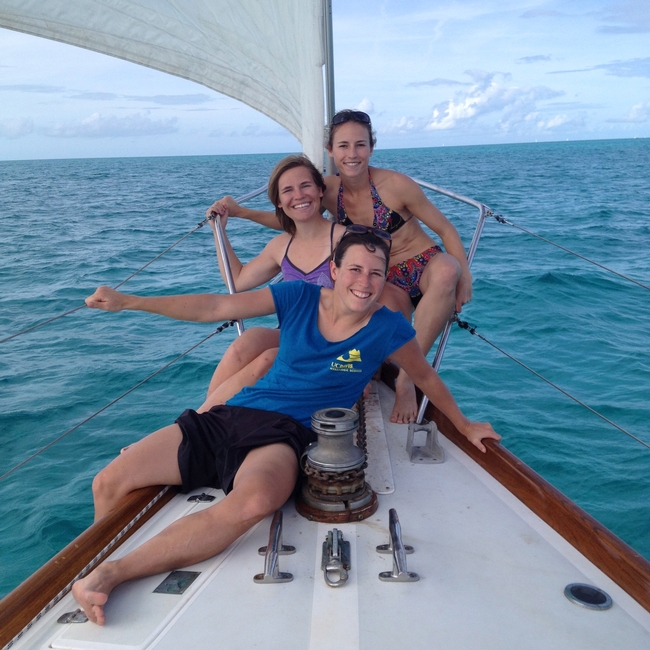
Image 5: Bringing some UC Davis Hydrology schwag to the Bahamas! Photo: Kathryn Foster.
References:
Abbott, Karen (2011). “If there's a man among ye: the tale of pirate queens Anne Bonny and Mary Read.” Smithsonian Magazine. http://www.smithsonianmag.com/history.
Army Corps of Engineers (2004). “Water resources assessment of the Bahamas.” http://www.sam.usace.army.mil/Portals/46/docs/military/engineering/docs/WRA/Bahamas/BAHAMAS1WRA.pdf
Christianson, Erik. “Sisters of the sea.” Bronze sculpture. http://www.erikchristianson.com
Exuma Cays Land and Sea Park. http://www.exumapark.org/
Integrated Coastal Management Planning (2012). “Integrating watershed and coastal area management in the small island developing states of the Caribbean: Technical Report: National Report for the Bahamas.” http://iwlearn.net/iw-projects/1254/reports/bahamas-national-report.pdf
Mount, Jeffery; Freeman, Emma; Lund, Jay (2014). “Water Use in California.” Public Policy Institute of California. http://www.ppic.org/main/publication_show.asp?i=1108

